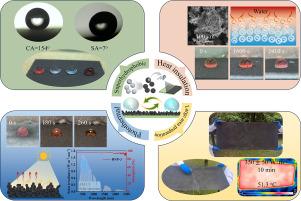用于抑制风力涡轮机叶片结冰和热老化的一体式绝缘超疏水光热涂层
IF 7.3
2区 材料科学
Q1 CHEMISTRY, APPLIED
引用次数: 0
摘要
现有的防/除冰涂料往往面临着由于夏季高温导致风力机叶片机械强度不足和加速老化的问题。本研究通过在中空玻璃微球(HGMs)表面化学镀镍,并与聚二甲基硅氧烷(PDMS)集成,制备了一种特殊的光热超疏水防/除冰涂层HGMs@Ni/PDMS (HNP)。电镀镍过程中激烈的化学反应和金属镍纳米粒子对光的散射作用使HGMs由白色变为黑色。结合局部表面等离子体共振(LSPR)效应,涂层表现出优异的光热性能,在1000 W·m−2的光强下,涂层表面温度可在100 s内从20°C升高到66°C。HGMs的中空结构和PDMS的低导热性协同作用使涂层具有优异的隔热性能,减缓了涡轮叶片的热老化,同时有效减缓了液滴冻结过程中潜热的释放,使得HNP-3在−10℃的冻结时间接近40 min。此外,一体式结构不存在层间键合问题,在HGMs表面生长的纳米级镍颗粒可以有效地增加与PDMS的键合点,使涂层具有优异的机械性能,并且制备方法简单,适合大面积制备。本文章由计算机程序翻译,如有差异,请以英文原文为准。

One-piece insulating superhydrophobic photothermal coating for suppression of icing and thermal aging of wind turbine blades
Existing anti-/de-icing coatings often face the problems of insufficient mechanical strength and accelerated aging of the wind turbine blades due to the high temperature in the summer. In this study, an exceptional thermally insulating photothermal superhydrophobic anti-/de-icing coating, designated HGMs@Ni/PDMS (HNP), was fabricated by electroless nickel plating on hollow glass microspheres (HGMs) followed by integration with polydimethylsiloxane (PDMS). The intense chemical reactions during the nickel electroplating process and the scattering effect of nickel metal nanoparticles on light cause the HGMs to change from white to black. Combined with the localized surface plasmon resonance (LSPR) effect, the coating exhibits excellent photothermal performance, and the surface temperature of the coating could be increased from 20 °C to 66 °C in 100 s under a light intensity of 1000 W·m−2. The hollow structure of HGMs and the low thermal conductivity of PDMS synergistically give the coating excellent thermal insulation performance, which slows down the thermal aging of the turbine blades while effectively slowing down the release of latent heat during the freezing of the droplets, resulting in the freezing time of HNP-3 at −10 °C being close to 40 min. In addition, the one-piece structure has no interlayer bonding problem, and the nanometer-sized nickel particles grown on the HGMs surface can effectively increase the bonding points with PDMS, resulting in excellent mechanical properties of the coating, together with its simple preparation method, which is suitable for large-area preparation.
求助全文
通过发布文献求助,成功后即可免费获取论文全文。
去求助
来源期刊

Progress in Organic Coatings
工程技术-材料科学:膜
CiteScore
11.40
自引率
15.20%
发文量
577
审稿时长
48 days
期刊介绍:
The aim of this international journal is to analyse and publicise the progress and current state of knowledge in the field of organic coatings and related materials. The Editors and the Editorial Board members will solicit both review and research papers from academic and industrial scientists who are actively engaged in research and development or, in the case of review papers, have extensive experience in the subject to be reviewed. Unsolicited manuscripts will be accepted if they meet the journal''s requirements. The journal publishes papers dealing with such subjects as:
• Chemical, physical and technological properties of organic coatings and related materials
• Problems and methods of preparation, manufacture and application of these materials
• Performance, testing and analysis.
 求助内容:
求助内容: 应助结果提醒方式:
应助结果提醒方式:


